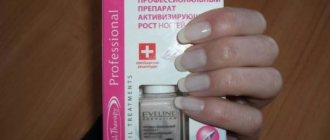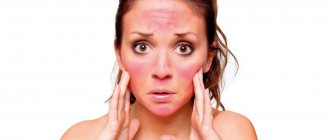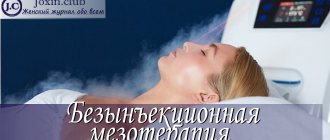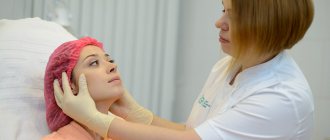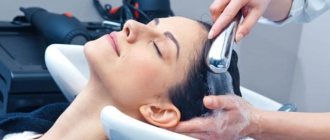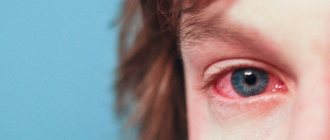What is this procedure?
WARNING : This cosmetic procedure involves the process of administering medicinal injections under the skin to smooth and reduce fine lines and wrinkles. The most popular drug is considered to be an injection based on butolotoxin type A, purified protein.
Today in the beauty industry, the most popular among doctors and patients are:
- "Botox".
- "Xeomin."
- "Dysport".
The action of the injections is based on muscle relaxation, which prevents the occurrence of wrinkles .
The effect is best seen on small muscles responsible for facial expressions, which lose elasticity with age. The principle of action of the drug is to block the transmission of impulses to muscles from nerve endings. The forehead stops wrinkling already in the second week after the procedure, since the skin continues to receive the necessary nutrition, and the muscles are limited in their ability to contract.
Read about the features of using Botox here, and from this article you will learn about exactly how botulinum toxin is used in cosmetology and see photos before and after the procedure.
Biochemical mechanism of toxicity
The heavy chain of the toxin is especially important for targeting it to specific types of axon terminals. The toxin must enter the axon terminals in order to trigger the paralysis mechanism. After the toxin heavy chain attaches to proteins on the surface of axon terminals, the toxin can be taken up by neurons through endocytosis. The toxin light chain is able to cleave endocytic vesicles and reach the cytoplasm. The light chain has protease activity. Toxin type A proteolytically destroys the Snap-25 protein (a type of SNARE protein complex). The Snap-25 protein is required for the integration of vesicles that release the neurotransmitter. Botox leads to the cleavage of the SNARE protein complex and thus prevents the fusion of neurosecretory vesicles with the persynaptic membrane of the neuron and the release of the neurotransmitter.
Although it has an effect on the nervous system, nerve paralytic treatments (namely injections of atropine and pralidoxime) increase
mortality rate, enhancing the mechanism of Botox toxicity. Botox is different from a nerve agent in that any of the substance detection tools (M-8 indicator or ICAM technology) will not show a positive result when tested. In addition, the symptoms of botulism develop relatively slowly (over several days), while the nerve agent effect can be immediate.
Return to content
Treatment of Botox poisoning
If symptoms of botulism are diagnosed early, treatment includes antitoxin, cleansing enemas, or extracorporeal bowel removal. A wound infection can be treated with surgery. To prevent this disease, information can be disseminated on how to properly process and preserve food, as well as familiarization at the public education level with the nature of botulism, possible ways of infecting it with humans and the consequences of the disease. Methods for diagnosing botulism include brain scans, nerve conduction studies, and myasthenia gravis testing. These methods help distinguish botulism from other diseases that manifest themselves in a similar way. An electromyographic study may be performed to differentiate between myasthenia gravis and Guillain-Barré syndrome (diseases with which botulism is often confused). Serum and wound cell culture testing for toxicity and toxicology testing of a stool sample are the best methods for detecting botulism. Laboratory testing of samples of the patient's blood serum or stool, which are then injected into mice, can also help identify the disease. However, the fastest way to diagnose botulism in humans is to use mass spectrometry technology, as it reduces the time spent on testing to three to four hours and helps identify seven types of toxin.
The mortality rate due to the disease from Botox between 1950 and 1996 was 15.5%, having decreased by 44.5% over the previous 50 years. Death is usually secondary to respiratory failure due to paralysis of the respiratory muscles, so treatment involves administration of an antitoxin and mechanical ventilation until the neurotoxins are eliminated or metabolized. A treatment administered on time is quite effective, although the antiserum cannot affect botulinum neurotoxin polypeptides that have already penetrated the cells. Sometimes functional recovery can take a period of time from several weeks to several months.
There are two main types of botulinum antitoxin used as a treatment for botulism.
- Trivalent (A, B, E) botulinum antitoxin is obtained from horse serum using antibodies.
- Heptavalent (A, B, C, D, E, F, G) botulinum antitoxin is also an equine antitoxin (IgG antibody), but is less allergenic and effective against all known types of botulism. It is available to the US Army. On June 1, 2006, the U.S. Department of Health and Human Services entered into a $363 million contract to supply 200,000 doses of heptavalent botulinum antitoxin over five years to replenish the strategic emergency stockpile.
Return to content
Video about Botox
Therapeutic research on Botox
In the late 1960s, San Francisco ophthalmologist Alan Scott and Edward were the first to work on preparing Botox for medical use. Until 1973, Scott tested botulinum toxin on monkeys, and in 1980 he first formally used it to treat strabismus (improper eye position) and blepharospasm (uncontrollable rapid blinking) in humans. In 1993, Pankaj Pasrich and his colleagues showed that Botox could be used to treat achalasia, a muscle spasm of the esophagus. In 1994, Bouchara demonstrated how Botox injections suppress sweating. This was the first example of Botox being used to treat a non-muscular disease in humans.
Blepharospasm and strabismus
In the early 1980s, ophthalmologists at universities in the United States and Canada continued to improve methods of treating diseases using Botox. By 1985, the treatment protocol for injection sites and the required doses for diseases such as blepharospasm and strabismus had been experimentally determined. It was noted that side effects are rare and easily treatable. The duration of the beneficial effects of the injections was only 4–6 months. Thus, people suffering from blepharospasm needed to repeat the injections two to three times a year.
In 1986, Scott, the manufacturer and distributor of Botox, could no longer supply it due to its inability to obtain product liability insurance. Patients found themselves in a hopeless situation as supplies of Botox were gradually depleted. American patients suffering from phlepharospasm had to stretch out the remaining injections for four months until insurance issues were resolved.
Global Botox sales are predicted to reach $2.9 billion by 2020, at a compound annual growth rate of 14%. The cosmetic surgery industry is projected to reach $4.7 billion in global market value in 2020, of which the United States is expected to account for more than $2 billion. In December 1989, Botox was approved by the US Food and Drug Administration for the treatment of strabismus, blepharospasm, and hemifacial spasm in patients over 12 years of age.
Return to content
Cosmetic purposes
The cosmetic effects of Botox on wrinkles were first documented by Sacramento, California plastic surgeon Dr. Richard Clark and published in the Journal of Plastic and Reconstructive Surgery in 1989. Canadian couple ophthalmologist Carruthers D.D. and dermatologist Carruthers D.A. in 1992, they were the first to publish the results of research on the use of Botox to get rid of frown lines between the eyebrows. As reported, similar effects were observed in experiments by a number of other independent research groups (Breen and the Columbia University group). After official testing, on April 12, 2002, the Food and Drug Administration announced its official recognition of Botox as a treatment suitable for the temporary improvement of the glabellar fold. Subsequently, the cosmetic use of Botox became widely accepted by many celebrities who considered it less invasive and/or artificial compared to other plastic surgery methods. The effects of this cosmetic procedure vary, but can last up to eight months. The US Food and Drug Administration has approved an alternative method of testing the product for safety amid growing public concern over whether "lethal dose 50" testing is performed on every batch of the drug that reaches the market.
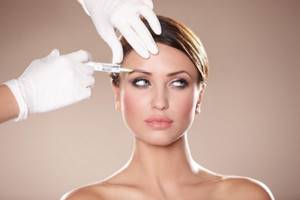
Muscle spasms
Botox is increasingly being used as a treatment for conditions associated with muscle pain and is increasingly gaining acceptance in many European countries. Confirmation of the effectiveness of Botox in the treatment of a number of other diseases (including prostate dysfunction, asthma, etc.) still requires appropriate research.
Upper motor neuron syndrome
Botox is now a common treatment for muscles damaged by upper motor neuron syndrome (cerebral palsy) and muscles that are unable to stretch properly. Muscles affected by upper motor neuron syndrome are often characterized by weakness, loss of reciprocal inhibition, decreased motor control, and hypertonia (including spasticity). Joint movement may be limited by severe muscle imbalances associated with upper motor neuron syndrome, in which some muscles have increased tone and impaired ability to stretch. Injections given into hypermobile muscles to reduce their rate of contraction can improve the ability to reciprocate and thus enable movement and exercise. In June 2009, using Botox to treat increased muscle tone enabled an Australian man to walk again. After suffering a stroke twenty years ago, he could only move in a wheelchair.
Return to content
Sweating
While treating patients with hemifacial spasm at Southend Hospital in England in 1993, Khalaf Bouchara and David Park were the first to demonstrate how Botox injections suppressed sweating. These were the first attempts to use botulinum toxin to treat a non-muscle disease in humans. Bouchara further confirmed the effectiveness of Botox in the treatment of hyperhidrosis (excessive sweating). Botox was later approved for the treatment of excessive sweating in the armpits. We are talking about the so-called axillary (axillary) hyperhidrosis, the causes of which are unknown and which cannot be treated with topical medications.
Cervical dystonia
Approval from the US Food and Drug Administration for the use of botulinum toxin type B for the treatment of cervical dystonia was received on December 21, 2000. The brands that produce botulinum toxin type B in the United States and the European Union are Myobloc and Neurobloc, respectively.
Chronic migraine
Botox (OnabotulinumtoxinA) received approval from the US Food and Drug Administration for the treatment of chronic migraines on October 15, 2010. To get rid of chronic migraines, this toxin is injected into the head and neck area. The approval was granted because two supported trial results were presented showing that patients treated with Botox experienced small improvements in chronic migraine headaches.
Since then, several additional randomized controlled trials have shown that Botox, when administered prophylactically to patients with chronic migraines, improves headache symptoms (in those with headaches related to: external pressure, reduction in the overall duration of chronic migraines (up to 30 years of age), “detoxification” in patients with daily headaches due to taking excessive doses of medications).
Return to content
Denaturation
Botox changes its natural properties at temperatures of 80°C (176°F) and above.
Sources of Botox
The production of Botox is ensured by the following microorganisms: Clostridium botulinum, Clostridium butyricum,
Clostridium baratii and Clostridium argentinense
.
Foodborne botulism can be acquired by consuming canned food that has not been properly cooked. Most cases of botulism in children could be avoided by knowing that the bacteria that causes the disease are found in soil and dust. Bacteria can be found around the home on floors, carpets and countertops, even after they have been cleaned. Microorganisms that contribute to the development of botulism in children may be contained in honey, so children under twelve months should not eat this product. Honey becomes safe for those who are one year old and older.
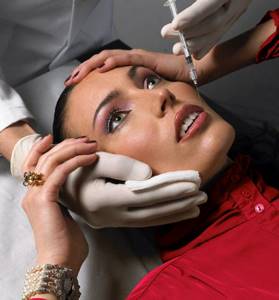
Chemical review and deaths
There are seven serologically detectable types of toxin, designated A through G. In addition, six of them have subtypes. The toxin in question is a polypeptide with two chains (heavy chain (100-kDa) and light chain (50-kDa)) that are linked by a disulfide bond. The light chain is an enzyme (proteolytic enzyme) that degrades a complex of proteins (Snap-25, syntaxin or synaptobrevin) at the neuromuscular junction, preventing the anchoring of vesicles to the membrane for subsequent release of acetylcholine. By preventing the release of acetylcholine, the toxin interferes with nerve impulses and causes mild muscle paralysis. This distinguishes botulism from tetanus, which is characterized by spastic paralysis.
There are more than 70 structures of this toxin listed in the Protein Structure Database (PDB).
This substance is the most toxic of all known, its average lethal dose is about 1 ng/kg when administered intravenously and 3 ng/kg when inhaled. This means that, depending on the method of administration, approximately 90–270 nanograms of Botox could be enough to kill a person weighing approximately 200 pounds, and four kilograms of the toxin, if distributed evenly, could kill the entire population of the globe.
The effectiveness of Botox is best summed up by the following quote from the annual report: “In 2011, we needed less than a gram of the original neurotoxin to meet global demand based on 25 criteria approved by government agencies around the world.”
Food-borne botulism usually occurs when food contaminated with spores is consumed under anaerobic conditions, allowing the spores to germinate and develop. Developing (vegetative) microorganisms produce the toxin. It is the ingestion of the toxin itself, and not spores or vegetative bacteria, that causes botulism. Infant and wound botulism occur as a result of infection with spores, which further develop and produce a toxin, after which symptoms of the disease appear.
Cooling the product at temperatures below 3 C0 retards the development of Clostridium botulinum bacteria. These microorganisms are also susceptible to high salt and low pH levels. The toxin itself is destroyed very quickly by exposure to heat, such as when cooking. On the other hand, the spores that produce the toxin are not sensitive to heat and survive in boiling water for a long period of time. Fortunately, ingestion of spores is not dangerous (except for children), since in the oxygen-rich and acidic environment of the adult digestive system, spores are not able to develop and produce Botox.
Botox is recognized and dangerous as a potential biological weapon.
Return to content
Botox Manufacturers
In the USA, Botox is produced for both medicinal and cosmetic purposes. The drug Xeomin (manufactured in Germany) is used in the USA for both medicinal and cosmetic purposes.
Dysport, a medicinal form of toxin type A, is manufactured in Ireland and is intended for the treatment of focal dystonias and for cosmetic use in the United States and around the world (available in 100, 300 and 500 units). Botox preparation (50 and 100 units) is produced at the Lanzhou Institute in China. In 2009, the production of a Botox drug called Neuronox was launched in South Korea. In America, Neuronox is also known as Siax. produces this toxin and sells it under the brand name “Xeomin”. Solstice Neuroscience LLC (US subsidiary) markets its product under the brand names Myobloc or Neurobloc, even though it contains botulinum toxin type B rather than the common toxin type A found in Botox.
Contraindications and indications
The procedure for administering the drug is not complicated; it requires special training and compliance with the rules . It is necessary to obtain a comprehensive consultation with a doctor and find out about the likely risks or possible contraindications. It is important not to undergo the procedure if there is the slightest risk, since unexpected consequences can distort the appearance for a long time.
The most common contraindications for Botox injections:
- Presence of neuromuscular diseases.
- Postoperative period in case of plastic correction.
- Menstruation.
- The presence of an active form of infectious disease.
- Aggravated periods of chronic diseases.
- Fever or cold.
- Existing allergic reactions to the ingredients of purified protein (you can find out whether there can be an allergy to botulinum toxin and filler and how this is expressed here).
- Taking anticoagulants or antibiotics.
- Oncological diseases.
- Presence of a reaction to the toxin used.
- Hemophilia.
- Lactation or pregnancy period.
- Minor age.
- Presence of tissue scarring.
- Autoimmune diseases.
- Inflammatory processes or pustules present at the site of upcoming injections.
- Myopia.
Watch a video about contraindications for the Botox procedure on the forehead:
Before resorting to injections, you should consult with a specialist and find out about all contraindications so as not to harm the body.
Injections should be done if:
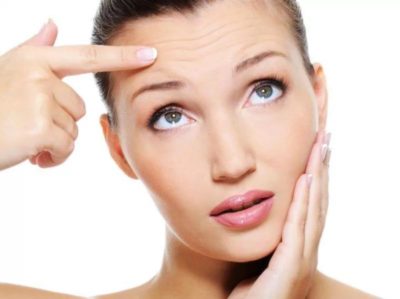
mimic wrinkles appeared in the upper part of the face;- muscles are overstrained;
- horizontal or vertical folds have appeared;
- there is facial asymmetry;
- eyebrows are lowered.
Consequences after Botox: what doctors are silent about, side effects from the procedure
Do you want to experience the effects of Botox injections, but are you afraid of the consequences and complications? Have you heard a lot of scary information about the terrible side effects of this procedure? Do you want to know all the details that clinic specialists keep silent for advertising purposes? We will tell you the most interesting information on this hot topic.
What is Botox
Botox injections are prescribed only after a thorough examination of the body.
A drug called Botox consists of botulinum toxin A, obtained from the anaerobic bacteria Clostridium botulinum.
It is a nerve poison that causes paralysis of muscle tissue when it penetrates into its structure, but due to low concentrations it is not capable of causing harm to health.
As a result of such actions, the muscle and the surrounding surface of the skin completely relax, which leads to the effect of smoothing and disappearing wrinkles.
Over the course of several months, this toxin is completely eliminated from the patient’s body naturally, and neuromuscular connections are restored.
Botox injections are prescribed only after a thorough examination of the body in order to identify all the patient’s contraindications. In addition, a competent specialist must correctly assess the initial state of the facial muscles in order to exclude the possibility of immobility in certain areas of the face.
The skin surface requiring correction must be pre-treated with an antiseptic solution, as well as local anesthetics (if necessary). After the procedure is completed, the patient can return to his work duties and lead a normal lifestyle.
What are the contraindications for use?
If such a procedure is performed by a qualified specialist who has the necessary knowledge and solid experience, there are usually no side effects.
However, there are cases of serious complications caused by many factors.
The doctor is obliged to warn his patient about the list of contraindications to the use of Botox in order to avoid dangerous consequences and significant side effects. This list includes a ban on the procedure in the following cases:
- pregnancy and breastfeeding;
- glaucoma diseases;
- the presence of infectious diseases in the body;
- the presence of immunological disorders;
- individual intolerance to botulinum toxin and tendency to allergic reactions;
- the presence of dermatitis and other diseases of the epidermis;
- increased body temperature;
- presence of diseases of the hematopoietic system;
- taking antibiotics and anticoagulants;
- the presence of oncological processes in the body;
- epilepsy diseases;
- the presence of foci of inflammation in the area of manipulation;
- atony of the facial muscles (age-related weakening of muscle tissue);
- weakened immune system of the body.
At the age of 45 - 50 years, many women experience atony of the facial muscles, associated with age-related loss of muscle strength, so additional administration of Botox in this case will lead to even greater weakening, as well as sagging due to paralysis.
The drug Botox has been in the service of medicine for many years, during which it has repeatedly undergone thorough testing and clinical studies for possible complications. During these experiments, the following facts were established:
- Botulinum toxin used for injections is used in very small dosages, and therefore is not capable of causing botulism;
- in the case of an individual allergic reaction - intolerance to the drug, a rejection reaction may occur, requiring therapeutic manipulation;
- In a large number of cases, after using Botox, the following were observed: skin redness, swelling, and inflammatory reactions.
What reasons can cause side effects?
The most common causes of complications after the Botox procedure are considered to be medical errors.
The consequences of using Botox are conditionally divided into 3 groups, depending on the root cause of their occurrence:
- Unqualified actions of a specialist/doctor.
- Ignoring compliance with special rules by the patient himself.
- Individual reaction of the body to botulinum toxin.
What mistakes can a doctor make?
The most common causes of complications after the Botox procedure are considered to be medical errors. They are:
- injection of the drug into inappropriate areas of the face that respond inadequately to the process of complete relaxation, resulting in asymmetry of the oval and contours;
- deviations in the choice of the correct dosage, that is, with a smaller amount of botulinum toxin administered, there will be no visible effects from the manipulation, while a slight excess of the dose can turn the face into a motionless mask;
- ignorance or ignoring the rules for subcutaneous/muscular diffusion, which can provoke migration of the drug to neighboring facial tissues, leading to their ptosis (drooping). There are known cases of local accumulation of the active substance under the skin in the eye area, which leads to swelling and local overdose;
- incompetence of the specialist who carried out the procedure with gross violations, which may result in: drooping of the upper eyelid, distortion of facial expressions and facial expressions, drying of the mucous membrane of the eyes due to impaired blinking, bags in the eye area, swelling of the face, asymmetric changes in proportions, paralysis of the circular muscles of the oral area leading to difficulties while eating;
- failure to comply with the temperature conditions of storage of the drug, leading to the loss of its basic properties.
In the process of metabolic removal of botulinum toxin molecules, most side effects are eliminated, but there are known cases of long-term accumulation of the drug, which can bring a lot of trouble and disappointment.
What can patients do wrong?
A large proportion of problems and complications are associated with patients ignoring the conditions of the rehabilitation regime and the strict regulations of actions that must be observed. They are:
- the need to hold the head level and refuse a horizontal position during the first hours after the manipulation;
- prohibition on prolonged bending of the body associated with lowering the head down;
- excluding any procedures associated with an increase in skin temperature (baths, saunas, massages, sports events);
- prohibition of drinking any alcoholic beverages;
- avoiding rubbing the face, especially in the eye area and injection sites;
- taboo on taking special medications (for example, strong antibiotics).
What may be the individual reaction of the body?
Botulinum toxin is capable of causing rejection/intolerance reactions associated with the individual susceptibility of the body. They are divided into 2 main groups. The first is associated with the occurrence of complex inflammatory reactions that form at the sites of drug administration, and the second includes hypersensitivity reactions to the toxin, expressed in severe swelling and the development of anaphylactic shock.
In order to prevent such complications, it is necessary to first test for the body’s sensitivity to the Botox toxin, and also categorically not to carry out manipulation during the course of acute infectious diseases and a weakened immune system.
Possible long-term consequences of the procedure
For a long period of time, it was believed that Botox drugs did not have long-term side effects, but through careful research it turned out that this was not the case.
It is known that in some cases, complications may appear in the patient after a long period of time has passed since the procedure, without any pain. These consequences may include:
- total change and disruption of facial expressions caused by redistribution of muscle load and motor activity of individual zones;
- atony, general weakness of the entire muscular system of the face;
- loss of elasticity and the appearance of excessive dryness of the epidermis as a result of trophic changes occurring in the tissues.
In most cases, the above complications are rarely eliminated and are practically impossible to correct.
In addition, complications from the use of Botox may occur in the form of:
- spasm of the eyelids;
- drooping eyebrow arches;
- subcutaneous hemorrhages;
- impaired lip mobility (when it is inserted deep under the skin);
- headaches;
- severe swelling of the places where the drug was administered.
Unpleasant sensations and side effects are possible in cases of rapid injection of botulinum toxin under the skin, as well as repeating the procedure more than once a year.
This drug requires professional training of the specialist who administers it and does not tolerate amateurs who are engaged in such a business solely to increase personal profits and do not care about the consequences for each patient.
The identified disadvantages of the drug include:
- inability to eliminate deep-lying wrinkles;
- low effectiveness in relation to folds located in the chin and cheeks, associated with their non-facial nature;
- limited validity period of the procedure, lasting in each case individually - from 3 to 6 months from the date of execution.
: The first Botox - author's review! Shock!
Only after carefully assessing all the pros and cons can you resort to Botox injections. We wish you success!
Advantages and disadvantages
The procedure is simple, but unwanted effects may occur . The reasons for the occurrence of negative consequences may depend on the quality of the drugs used, qualifications or accidental errors during the injection process, and the body’s special reaction to the composition of the drug.
Why is it worth doing?
Successful forehead Botox has a long-lasting effect of smoothing the skin in the injection area. The success of the procedure can most likely be judged no earlier than a week after the injections (we talked about how many days after the results are visible here).
In the first days, marks may be noticeable at the skin puncture sites or insufficient uniformity of distribution of the injected product. But after a few days they will become invisible.
If the outcome is positive, the benefits of forehead Botox:
- The very next day after the procedure, a significant smoothing of existing wrinkles will become noticeable.
- Horizontal folds on the forehead are less deep or may disappear altogether.
- When using various facial expressions, the forehead remains motionless, new wrinkles do not form, since the substance has paralyzed the muscles.
- The overall appearance of the face becomes more youthful and fresh.
- There is no mask effect on the face, the eyebrows are as mobile as before.
Possible complications
If any difficulties arise or the Botox was done poorly, defects may occur:
- As a result of frequent manipulations using injections, blood circulation in the forehead area can be disrupted, causing paralysis of muscle fibers.
- The appearance of neoplasms and tumors at injection sites.
- Dry skin.
- Swelling of the lymph nodes.
- Decreased tone of the forehead muscles.
- Loss of facial expression in the eyebrows and brow ridges.
- Swelling at injection sites.
Where is the dangerous metal found?
Under natural conditions, aluminum is part of water and found in soil. On an industrial scale, it is used to purify not only water, but also a variety of food products, the production of household items, cans, containers, etc. At the same time, vegetables, fruits, and herbs already contain a dangerous component that comes from the soil. It turns out that there is no living creature or plant on the planet that does not receive aluminum. But according to the findings of scientists, in 90% of cases a mental disorder in the form of dementia does not develop. However, the controversy does not stop. The motivation for further research was numerous autopsies, in which large accumulations of aluminum components were found in four parts of the brain.
Worth seeing: Diagnosis of Alzheimer's disease
The specialists were divided into two groups. Some argue that healthy brain cells do not absorb a dangerous substance, regardless of its quantity. Others are confident that aluminum easily penetrates the brain due to everyday exposure to it at home, at work, etc.
Important: after studying the research results, medicine began to restructure and eliminated the use of metal in dialysis, the treatment of dementia, excessive activity, and the industry is gradually reducing its share in manufactured products.
Features of wrinkle correction
Botox on the forehead is done by both women and men who want to get rid of annoying wrinkles caused by excessive emotionality. Unlike the area under the eyes or around the mouth, visible wrinkles on the forehead cannot be eliminated using alternative methods such as contouring with hyaluronic acid.
With the introduction of Botox, it is easy to remove both horizontal and vertical wrinkles , thereby returning the desired appearance. Carrying out the procedure in different parts of the face is generally similar, the only difference is in the number of units of the substance administered.
Attention! The drug should be injected specifically into the muscle tissue, and not into the wrinkle that has formed on the upper part of the face.
Injection plastic surgery should be performed no more than 2-3 times a year . The full course of combating unwanted skin imperfections is 3-4 years with breaks of 6 months - after restoration of previous muscle activity by 50%.
What effect does the drug have?
Most often, patients aged 35 to 55 years apply for injections of the drug. The table shows an approximate division into age groups that are most likely to have certain indications for Botox.
| Age category, years | Before | After |
| From 18 to 27 | Minor horizontal, rarely vertical wrinkles. | Complete elimination of wrinkles. If there are deeper ones, then they become almost invisible. |
| From 27 to 40 | There are visible traces of wrinkles and folds. Shallow horizontal and vertical wrinkles between the eyebrows, which become more expressive when using appropriate facial expressions. | Fine wrinkles are eliminated, leaving light traces of deeper horizontal folds. Vertical eyebrow wrinkles are almost always eliminated without leaving any traces. |
| From 40 to 50 | Most often, longitudinal wrinkles on the forehead are already clearly defined and can be seen even in a relaxed state. | The skin of the forehead is smoothed out, but traces of deep wrinkles are clearly visible. Some wrinkles are not completely eliminated. |
| From 50 to 65 | There are all kinds of wrinkles, some of them are already very deep. There is a dense network of small wrinkles over the entire area of the forehead. | Fine wrinkles are eliminated and deeper ones are smoothed out, but the forehead skin is not completely straightened. |
Photo
You can see what the face looks like before and after botulinum toxin injections in the forehead in the photo below.
How many units of the drug are needed?
At the first consultation, the cosmetologist determines how many units of the drug should be administered. Based on the individual characteristics of the patient, her skin type, depth and severity of wrinkles, the dosage ranges from 10 to 30 units of serum. Even an experienced specialist can prescribe the dose of Botox incorrectly , so another appointment with the doctor is required after 1-2 weeks.
If the patient suffered from botulism, then his body has developed antibodies to botuloxin, and the drug, when introduced into the body, does not act, which prevents the effect from appearing.
Where and at what price is the service provided?
Not every salon can provide services, but only those that have a license for surgical and therapeutic cosmetology. The procedure is carried out in a specially equipped room that meets all sanitary standards. The patient has the right to request a certificate of conformity of the drug and documents authorizing its use.
The average cost of Botox in Moscow and St. Petersburg varies from 200 to 400 rubles per unit. If the price is lower, you should think about the quality of the drug and the qualifications of the specialist. You cannot skimp on beauty and health.
Does Botox cause Alzheimer's disease?
In the battle for ratings and likes, the Internet is filled with such scandalous headlines as: “Botox injections kill the brain, cause early dementia and Alzheimer’s disease.” The doctors of the Fifth Season sorority are forced to confront the “armchair experts” and dispel ignorant myths.
Galina Ivanovna Voronina is a dermatocosmetologist, specialist in the field of hardware cosmetology, MULTILINE laser technologies, mesotherapy, ozone therapy, botulinum therapy, contouring, photorejuvenation, photoepilation.
Work experience 16 years. Botox injections are a popular anti-aging procedure among millions of people around the world. Botulinum toxin has been used in medicine since the early 80s. But the controversy surrounding this drug continues. Someone is stirring up fears for obvious reasons to agitate the public and make money from it. In the battle for ratings and likes, the Internet is filled with such scandalous headlines as “Botox injections destroy the brain.”
Doctors are forced to confront “armchair experts” and dispel ignorant myths.
MYTH FIRST
INJECTIONS CAUSE EARLY DEMENTIA AND ALZHEIMER'S DISEASE.
The source of such assumptions is the loud statements of one Italian scientist, after a minor experiment on rats. Other repeated serious studies of medical botulinum toxins have not confirmed these assumptions, but the publishers have modestly ignored the need for a refutation.
Let's dot the i's.
We read the description of the drug: “Botulinum toxin is concentrated for some time at the site of its intramuscular injection before it enters the systemic bloodstream. When administered in therapeutic doses, it does not penetrate the blood-brain barrier and does not cause systemic effects. Rapidly metabolized to form simpler molecular structures. Excreted by the kidneys in the form of metabolites.”
Note that the information on therapeutic doses refers to the use of the drug in neurology, which means the injection of up to 200 units into one muscle! The ban on use during pregnancy and lactation, as in the case of other serious pharmaceutical companies, is based on the lack of experimental data in this group. Moreover, a study of "random" patients who were unaware of their pregnancy and had the procedure demonstrated no statistically significant difference in maternal and infant vital signs compared with those who did not receive botulinum toxin.
The drug consists of two components: the first shell of hemagglutinin and non-hemagglutinin proteins, which is destroyed within a few hours from the moment of botulinum toxin injection into the muscle. These proteins are utilized and excreted like other blood plasma proteins: through the kidneys. As for the second component of the neurotoxin itself, after entering the nerve ending it interacts with acetylcholine receptors of the presynaptic membrane, completely blocking it. This is the point of using botulinum toxin.
After four months, new motor fibers sprout, and the old ones are utilized by the body, a proven law of nature. Think about how many muscle, nerve fibers, epithelial cells, etc. were renewed in our body within six months. Self-renewal of the body is a fundamental factor in the life of living beings; regenerative function is one of the main characteristics of all living things. Thus, talking about the “accumulation” of a drug in the brain is pure manipulation of facts and phrases taken out of the context of research.
MYTH SECOND
BOTOX MAKES YOU STUPID
“Doesn’t Botox smooth out the wrinkles?” Dubious sources talk about a possible connection between a decrease in brain activity against the background of blocking facial hyperactivity. As an example, the opinions of scientists are given that facial expressions activate the mind, and after injections the activity of facial muscles decreases. It turns out that if a person is naturally unemotional or knows how to control his facial expressions, he is dumber than people with “active facial expressions”? Are monkeys who constantly grimace child prodigies?
One more final argument in our article, but not the last, for doubters to be critical of information received from incompetent sources.
Botox is approved for use in medicine and in pediatrics as well. Its long-term use is the main proof of its benefits and safety. Doctors will not correct strabismus in a child knowing that in the future this may lead to blindness or, even worse, to devastating, fatal consequences for the brain. Let us remind you that medical indications include the following pathological conditions:
- hemifacial spasm;
- paralytic form of strabismus;
- blepharospasm;
- local spasm;
- spastic torticollis;
- cerebral palsy;
- hyperhidrosis;
- migraine.
- etc
REALITY
The safety of the procedure, as well as other manipulations with our health and beauty, depends on the quality of the drug and the qualifications of the specialist. The main danger of Botox today is the large number of counterfeits on the market. In pursuit of cheap prices, unscrupulous cosmetologists, usually working at home or in dubious cosmetology clinics, purchase suspicious products from distributors who supply counterfeit drugs and medical products not registered in Russia. As a result, doctors face serious complications after such injections.
Preparations containing botulinum toxins, like any other, have contraindications and side effects. Cosmetologists with insufficient experience or questionable competence can incorrectly administer the drug and cause facial asymmetry, drooping of the eyelid and other unpleasant consequences.
Trust the professionals and your beauty and health will be out of the risk zone!
How is the procedure performed?
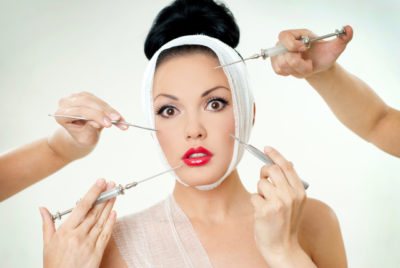
First consultation. The doctor determines the required amount of the drug and talks about possible side effects.- The patient should not drink alcohol or antibiotics the day before the injections. It is also undesirable to smoke or drink strong tea or coffee on the day of the procedure.
- The doctor cleans and disinfects the treated area.
- The patient is asked to frown and raise their eyebrows to mark the areas where Botox will be injected.
- An anesthetic cream is applied to the injection areas to avoid discomfort.
- With a thin needle, the drug is injected under the skin to a depth of approximately 7 mm.
- Ice is applied to the treated area.
You can clearly see how Botox is administered in the video:
Is it possible to inject the drug at home?
Some women prefer to take care of their face at home. It is strictly forbidden to inject Botox yourself - the procedure should only be carried out by a certified specialist. At home, it is possible to use non-injection methods to maintain youth.
Homemade cosmetics are prepared using natural ingredients, but are significantly inferior in effectiveness to injection plastic surgery. One of the most popular skin care methods at home is a cream with a Botox effect. It refreshes the face and helps prevent the appearance of the first wrinkles.
You can replace beauty injections with appropriate masks and lotions , which extremely rarely cause negative consequences and allergic reactions.
What to do if the procedure was unsuccessful?
| No. | Cause | Consequences |
| 1 | Large dose of the drug | It has a strong effect on the facial muscles, causing paralysis. Reduced activity of the forehead muscles can lead to increased activity of others, causing wrinkles to appear in their area. |
| 2 | Incorrect injection site | May lead to swelling and sagging muscles. If the needle hits a blood vessel, it will rupture and release a small amount of blood. There will be no significant harm to health, but there will be bruises or bruises. |
| 3 | Frequent use of the drug | It can lead to partial or complete muscle atrophy, causing drooping of the facial contour and the appearance of a frozen expression on the face. |
If a tragedy does occur, it is necessary to look for recovery methods . Massage helps to stimulate muscles and skin, improve blood circulation. This helps the bruising and swelling disappear. An experienced physiotherapist will be able to assess the situation and recommend physiotherapy treatments.
LiveInternetLiveInternet

Currently, the Botox procedure has become very popular both among cosmetologists and among the population. The frantic pace of life, society's high demands on appearance and a catastrophic lack of free time create a complex of prerequisites when expensive and dubious “pleasures” poured into the market for cosmetology services from the West, with the emphasis on obtaining QUICK RESULTS.
One of these truly questionable from the point of view of logic and common sense is the Botox procedure, which is widely advertised in many beauty salons.
Let's first look at the history of Botox. Botox is a botulinum poison discovered several centuries ago by German scientists who discovered it as the cause of fatal rotten sausage poisonings. People who were poisoned by spoiled food died in terrible agony from respiratory paralysis. Thus, BOTULIN is a PARALYZING POISON.
While studying the effects of botulinum, modern scientists became interested in the fact that the skin over the paralyzed muscle smoothed out, since the muscle could no longer contract and therefore could no longer cause wrinkles. It was this feature of botulin that attracted modern Western doctors in the early 80s to use it in small doses for medicinal and cosmetic purposes.
The main criterion was a quick result and the absence of any effort on the part of the patient. This attracted the attention of a wide range of specialists specializing in the beauty industry. Just a few injections and that’s it, you start to look at least 10 years younger.
Blinded by bright advertising and promising slogans, people flocked to get the magic injections. Indeed, the first results of this procedure were truly impressive. Yesterday's aging ladies were turning into young ones before our eyes - isn't this the result?
BUT! One very important “BUT” appeared, which began to spoil the whole effect. The fact is that with Botox, the required paralysis lasts only six months to a year. Those who have a young body or strong muscles - even less. During this time, the muscle begins to degrade quite significantly. The skin above it does not become younger, i.e. The process of skin aging continues. This is also facilitated by impaired blood supply to the skin area associated with muscle paralysis.
It is necessary to understand the difference between a RELAXED and RESTING MUSCLE and a PARALYZED MUSCLE. These are two completely different states. And when a DOCTOR says that Botox relaxes muscles, he is openly lying and misleading you.
Since the processes occurring in a naturally relaxed and resting muscle and in a muscle paralyzed by poison are completely different. One is resting and gaining strength at this time, while the other is trying to intensively restore the damage caused to her and not only to her, but to the entire body, because toxins that enter the body are neutralized by the entire body as a whole.
And even though doctors say that Botox is completely harmless to the body in the doses they use, adults and reasonable people should understand that the long-term effects of Botox have not yet appeared (it began to be used 15 - 20 years ago) and it is simply impossible to talk about the harmlessness of the drug - Only now American doctors have begun research in this area. In our country, such research is simply not conducted.
But here’s what Nata Topchiashvili, candidate of medical sciences, president of the company, said in her report: “Botox deforms the structure of collagen fibers and greatly dries out the tissue, which causes the skin to age faster.”
One of the main contraindications to Botox is atony of the facial muscles, which is observed in most women over 40. However, this is often ignored by unscrupulous doctors who make money from Botox.
According to the observation of a doctor from New York, Botox, aimed at combating the signs of aging, itself, in turn, causes the appearance of new wrinkles. This is due to the fact that when some muscles are paralyzed, the load on adjacent muscle groups involved in facial expressions increases, and, therefore, the appearance of wrinkles in another place. As one former Botox patient accurately noted: “Wrinkles don’t disappear, they just migrate.”
The myth that is now actively fed by all cosmetologists who make money from Botox, that Botox supposedly has a positive effect on the psyche, freezing emotions, came across new arguments from medical researchers from Holland who claim that neuroses arise in Botox patients, since emotions do not disappear, but are driven away inside and, not being able to escape through facial expressions, exert their destructive effect from the inside.
Below I will provide a list of all possible “harmless” consequences of Botox:
atrophy of the paralyzed muscle atony of adjacent muscles drooping eyebrows and upper eyelids on the eyes “doll mask” or unnatural facial expression swelling repeated injections do not give the desired results acceleration of facial aging general sagging muscles
The funny thing is that the long-term effects of this Botox can be treated with nothing more than special exercises. In short, we return to what we left - from working on ourselves. That's where we had to start.
source https://asver.ru/index.php/2011-10-28-17-38-17/31-2011-10-28-17-07-33
Side effects
There is always the possibility of an unsuccessful outcome. To minimize this possibility, you need to take care of choosing a certified cosmetologist, a quality product, and getting your health in order at the time of the procedure.
Side effects of Botox forehead:
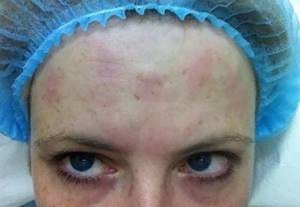
Redness in the area of skin injections.- Formation at the injection site of a lump.
- Dryness or double vision.
- Rising temperature.
- The distribution of the substance was uneven.
- The skin of the eyelid or forehead has sagged.
- The injection site may be sore for some time after the injection.
In general, negative consequences are associated with incorrectly performed procedure techniques or the ingestion of Botox into the body. In any case, you can wait no earlier than several days for these defects to be eliminated . If the symmetry of the face was affected due to uneven distribution of the drug under the skin (for example, the skin of the forehead sagged after botulinum toxin injections), then such a failure will need to be tolerated for 3 to 5 months.
Read about how to remove Botox from your face after unwanted consequences after injections have appeared here, and from this article you will learn about why swelling occurs after Botox and how to get rid of it.
Botox has been credited with having an antidepressant effect
Brazil / 20th Century Fox, 1985
American researchers have found that Botox injections are accompanied by a significant antidepressant effect - regardless of the place of administration of the drug and the indications for its use. To do this, they analyzed the manifestation of side effects in more than 45 thousand patients who were injected with Botox - both for cosmetic and medical purposes. Scientific Reports offer options
suggest the effects of high-dose Botox on the central nervous system, as well as relief of selected symptoms of depression.
The main active ingredients of Botox are part of the group of botulinum toxins - protein neurotoxins that block signal transmission between neurons and muscle tissue, due to which the latter stops (partially or completely) contracting. Botox was originally developed to treat facial muscle spasms (or tics), but in the last few years the drug has become very popular in cosmetology: it is used both to smooth out wrinkles and to treat excessive sweating.
In cosmetology, Botox is most often injected into the muscles covering the glabella - the area of the skull between the eyebrows above the nose: smoothing these muscles reduces the number of visible facial wrinkles that appear, for example, when a person frowns (angry or upset). The use of Botox in this case also leads to an interesting side effect: some studies conducted in the last ten years indicate a mild antidepressant property of the drug.
To explain this effect, scientists propose a fairly simple mechanism: smoothing out wrinkles that appear as a result of the manifestation of negative emotions leads to the so-called facial feedback, according to which a person who does not express negative emotions feels them less often. This hypothesis, however, is very speculative: for example, a meta-analysis conducted last year indicated that smiling has little effect on mood.
However, the antidepressant effect of Botox still remains, and if the facial feedback hypothesis is eliminated, another explanation needs to be found. To do this, Tigran Makunts from the University of California at San Diego and his colleagues decided to test whether the antidepressant properties of Botox would depend on the injection site.
In total, scientists analyzed data on the side effects of more than 45 thousand patients who were injected with Botox for cosmetic purposes, to treat muscle spasms (in addition to tics, increased salivation and neck pain were also indicated), as well as to treat, for example, urinary incontinence. Participants, depending on the indications for the use of Botox, were assigned to a control group - with the same indications, but a different treatment.
The analysis found that participants who received Botox were diagnosed with depression and depressive symptoms 40 to 88 percent less often than control groups, and this effect was independent of injection site: depression and its symptoms were less likely to occur in people who received Botox for cosmetic purposes, and for those who have undergone therapy for muscle spasms and pain. In the treatment group for increased salivation and urinary incontinence, however, no effect was found: in the first case, due to a small sample, and in the second, the difference was simply insignificant (although in both cases there were depressive symptoms when using Botox, although and insignificant, but still lower).
Since the antidepressant effect of Botox persists regardless of where the drug is administered, facial feedback is actually an unlikely explanation for its existence. As an alternative, the researchers offer several options. First, at high doses, Botox can actually affect the central nervous system: in this case, it directly affects the parts of the brain responsible for regulating mood. Secondly, the reduction in depressive symptoms may be due to the fact that Botox reduces muscle tension, which is also often associated with depression. Thirdly, in some cases, Botox can act on the root cause of depression - a chronic disease: by relieving the symptoms of the latter, the drug reduces the symptoms and contributing affective disorder. However, more research is needed to establish the exact reasons, the authors say.
A 2020 study found that Botox injections were better for urinary incontinence than traditionally used electrical stimulation of the sacral nerves.
Elizaveta Ivtushok
What not to do after: list of prohibitions
Let's figure out what not to do after injections.
- Within 6 hours:
- Touch the injection site.
- Apply makeup or do other facial procedures.
- Take antithrombotic drugs.
- Lie.
- Tilt.
- From 6 hours until the end of the first day:
- Use a directed stream of hot air into your face (do not use a hairdryer).
- Eat spicy, salty and too fatty foods.
- Take flights.
- Touch the injection site.
- Take a hot bath or shower.
- Play sports (you can find out why you should refrain from playing sports after Botox here).
- Visit a cosmetologist for facial procedures.
- Go to the pool or sauna (read about why a sauna immediately after Botox is dangerous in our material).
- Sunbathe.
- Get vaccinated.
- Smoking.
- Drink tea, coffee, and alcoholic beverages (read about whether botulinum toxin injections are compatible with drinking alcoholic beverages here).
- Take antibiotics and some other medications (you can find out whether you can take antibiotics at the same time as Botox injections here).
- Pilling is prohibited.
TIP : If you strictly follow these rules, you can avoid possible unpleasant consequences.
The procedure for injecting Botox drugs under the skin is a very serious step, so you need to prepare and study all the information. Choosing a good clinic and a highly qualified specialist is a priority . It is this person who will be able to fully assess the need for a session, the likely risks and give the necessary effective advice.
Now you know how many days you should not drink strong alcoholic drinks after botulinum toxin injections in the forehead, and also what complications occur when the procedure is performed incorrectly.
Watch a video about what not to do after Botox injections:
Alternative Methods
Let us consider further what other drugs based on botulinum are actively used in Russia and how they work:
- Dysport;
- xeomin;
- lantox;
- relatox.
Regardless of the brand, the substance acts the same - it relaxes the muscle, thereby helping to smooth out wrinkles. The only difference is the price and production technology. The situation is different with fillers. It is a mistake to think that Botox and filler are similar techniques and compare which is better. Botox injections differ significantly from fillers in how they work. Fillers are injected under the skin rather than into muscle tissue. The skin becomes smooth and elastic by filling problem areas with the drug (hyaluronic acid, collagen, vitamin cocktail). You can find out which is better to use - Botox or filler here.
Important! To eliminate fine wrinkles, it is better to use filler.
How Botox affects the brain—literally
Neurological side effects make the cosmetic procedure not so safe.
Injecting Botox to smooth out wrinkles on the face will no longer surprise anyone. This procedure has long been considered purely cosmetic. And thanks to Hollywood, it has become widespread and quite unpretentious.
However, scientific research has revealed an unexpected side effect: Botox injections into the forehead and face rewire the brain's sensory map associated with the hands. Of particular concern is the fact that clients typically return for repeat injections, as the limited paralysis that the toxin causes lasts only two to three months. The main question is whether regular treatments over many years lead to permanent changes in the brain [1].
Botox is the brand name for botulinum toxin-a, one of the deadliest poisons known. The neurotoxin is produced by the Clostridium bacterium. These spores are often found in plants, soil, water and animals. Clinical botulism syndrome, which is often fatal, usually occurs from infection in a wound, or from insufficiently cooked food, or from spoiled canned food. The toxin paralyzes muscles by blocking the movement of acetylcholine, the main neurotransmitter between nerves and muscles.
We have long known that the brain is plastic, meaning that its contours and microscopic anatomy are easily changed. They physically change in response to a number of external influences. For example, violinists have a much larger brain map dedicated to non-flexible fingers than the same brain area in non-violinists. In recently blind braille learners, the cortical area dedicated to the "reading finger" expands significantly into the recently unused visual cortex.
In the sensory cortex of the brain, maps of the hand and face areas lie next to each other. After arm amputation, tactile signals from the face typically expand and move into territory recently deprived of sensory signals from the hands. Similarly, patients with facial paralysis due to Bell's palsy or stroke increased metabolic activity in the sensory cortex in the hand region. The clear principle at work is that the cortical representation of one body part expands in response to injury affecting another body part.
Based on this knowledge, one would expect hand maps to increase after a patient's face is paralyzed by Botox injections. However, everything happens exactly the opposite. This suggests that the changes in the cerebral cortex due to Botox facial palsy are essentially different from those observed after functional loss from amputation, facial nerve injury, or stroke. We must consider this within the established knowledge that during deliberate imitation of facial expressions, facial feedback modifies neural activity in the central circuits that express emotion [2].
The current explanation for this unexpected observation is that the limited paralysis caused by Botox deprives the brain of sensory impulses normally generated by movement of the forehead and face. Even more surprising is that both hands suffer from a loss of cortical brain activity after a relatively small loss of facial movement. Changes in brain rewiring depend on the dose: the more you use, the stronger the effect. Initial studies did not examine whether cortical remapping was limited to the arms or whether other parts of the body were affected. Later studies showed more widespread effects and unpredictable consequences on the nervous system. This suggests that anyone choosing this “cosmetic” procedure should think twice.
List of used literature:
[1] “Altered cortical activation from the hand after botulinum toxin treatment.” Ann Clin Translational Neurol 2014, 1:64-68 by Arko Ghosh and colleagues was the earliest reference to this phenomenon. See https://onlinelibrary.wiley.com/doi/10.1002/acn3.21/pdf Subsequent work by Dr Ghosh and others can be found at google scholar or PubMed.
[2] Weise, D., Weise, C., & Naumann, M. (2019). Central Effects of Botulinum Neurotoxin—Evidence from Human Studies. Toxins, 11(1), 21.
Website: www.psiblog.rf
Original article: Richard E. Cytowic — How Facial Botox Changes Your Brain—Literally, March, 2019
Translation: Ostrenko Anna Alexandrovna
Editors: Simonov Vyacheslav Mikhailovich, Shipilina Elena Ivanovna
Image source: foter.com
Key words: brain function, neural connections, psychotherapy, botulism, botox, cosmetology
Available for download:
- 300419 How Botox affects the brain - literally

